July in Texas is hot!
This year is no exception. Gardeners go out in the early morning to do chores like watering and maybe a little weeding. Then, we ignore our gardens until the evening when the temps will hopefully drop below 90 degrees.
For the last month or so, I’ve been cleaning up overgrown beds, pruning ugly plants and planting a few new plants from my stock. I added some lavender and some milkweed for the Monarch butterflies. In this heat, I’m watering daily and the little plants are doing well.
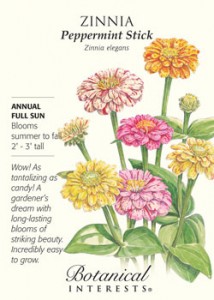

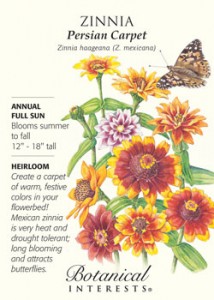

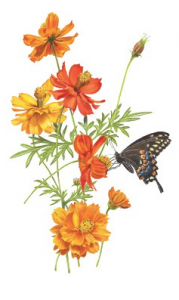
Cosmos, Bright Lights
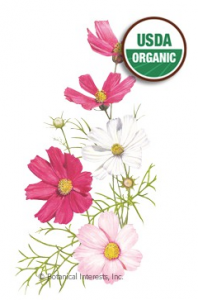
I also planted some seeds of colorful, Summer annuals. I like the old fashioned types, non-hybrids, so they’ll reseed for me next late Winter or Spring. I use the expired packets from Botanical Interests- you can find fresh seed here on the website. I love cosmos and zinnias of all types. They’re so cheery.
What I have found interesting, however, while working with the herbs in the beds and in large containers, is which herbs seem to like a heavy pruning this time of year and which herbs don’t seem to need it.
Some herbs that may need pruning include mint.
Mints tend to become leggy by this time in the summer after their rampant Spring growth. Unless you’ve really been using them a lot to keep their growth compact, they will benefit from pruning this time of year.
I find this is the perfect time of year to prune the mints back. The intense heat of summer here in Texas is not kind to mints. So, I like to prune off the long growth and dry it for use in iced and hot teas and allow the plant to put on new growth. This practice gives the plants some rest from having to pump so much water out to the ends of the stems during the hottest time of the year.
This mint need pruning. You can see leggy growth and some bug eaten leaves.
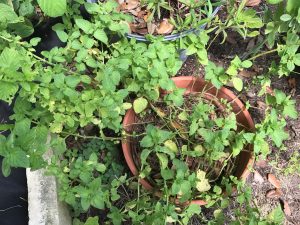
Mint Flowers- don’t be afraid to let your mints flower. The flowers bring beneficial insects to your garden. Use the flowers in teas and drinks, too!
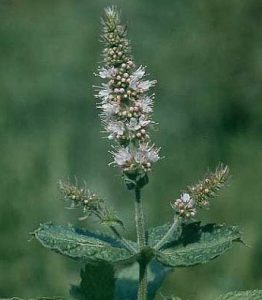
Close up of a peppermint flower. Bees love these!
This is also a good time to divide your mints. Whether they’re growing in containers or in the ground, you can dig sections out or dig the whole plant up and see where new little sections have started themselves. Clip those off the main plant and replant or repot them. If you see brown or shriveled roots on the main part of the plant, prune those off, too. Then, repot or replant the main plant- or discard it if it looks tired or if the center of the plant has died out.
Just remember to keep all the parts watered well after transplanting or dividing and you’ll be rewarded with new growth in just a few weeks. Meanwhile, you have the dried mint for your tea.
Oregano/Marjoram
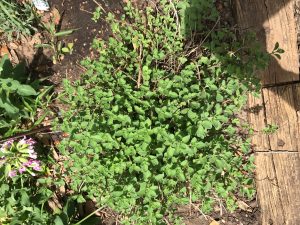
This oregano was pruned about 3 weeks ago.
By this time of year, my oregano and marjoram have flowered or are flowering. Since these are perennial plants, you can enjoy the flowers and leave them on until they are played out. Flowers from the oregano family bring beneficial insects to your garden and they are pretty. If you like, you can clip them for cut display or use them to flavor your cooking.
There are several types of oregano designated a ‘flowering oregano’ or ‘ornamental oregano’. These are cultivars that have been bred for their more dramatic flowers. Alas, some of the flavor has been lost from these types and they are best used as hardy ornamental landscape plants.
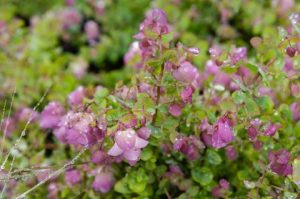
This is a picture of the lovely ornamental oregano, Kent Beauty. The picture is from Mostly Natives Nursery.
Whichever type of oregano you are growing, after the flowers fade, the plant doesn’t look its best. The stems can become leggy and the spent flowers are rather unattractive. So, now’s the time to prune the flower heads off. You can also prune the whole plant back if it’s gotten too big or needs shaping. Remember the rule: for best results, don’t prune more than about 1/3 of the growth of the plant.
Basil
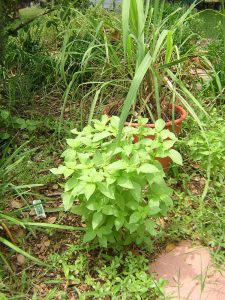
Nicely pruned Lemon Basil
Since basil is an annual, it has different characteristics from the previous plants I’ve mentioned. It flowers much more readily, as those of you who grow basil know. We attempt to keep it from flowering by frequent harvesting. Once the plant gets older and the stem starts to become woody, the tops will begin to flower signaling that the plant is near the end of its annual cycle. We can clip off flowers to maintain the leafy, succulent growth for a while, but eventually, the plant wants to flower, set seed and die out.
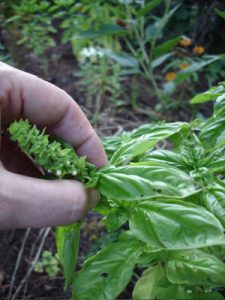
Pinching flowers from a Genovese Basil Plant
If you haven’t been harvesting your basil frequently and the plant still has leafy growth all along the stem, go ahead and prune the stems back, but not so far as to get into the woody growth, if you have that. It’s unlikely the plant will leaf out again if you prune back to the woody growth. By pruning into just the newer, soft wood, your basil will send out new branches and leaves for your next harvest.
It is best to harvest/prune your basil fairly frequently during its active growth. That way, you avoid getting those long stems that lose leaves along the stem and end up with just the fresh, new growth at the top. If your basil looks like that, it’s probably best to take it out and put in a new plant.
I am often asked if basil can be grown from cuttings. And, the answer is a resounding YES! The best time to take basil cuttings is in the early growth stages of the plant. I don’t mean when it’s very young and soft, but before it looks like it’s going to begin to flower. Any cutting you stick and root is the same age as the plant you took it from. So, if the stem you’re rooting was about to flower when it was attached to the plant, it’s going to flower right away as a rooted cutting, too.
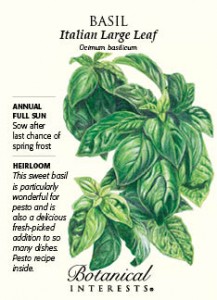
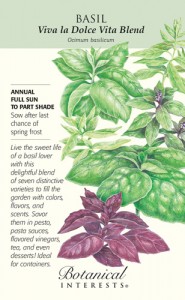
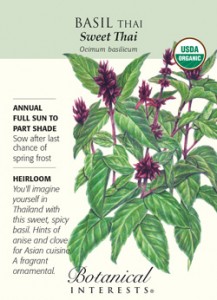
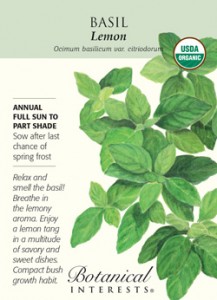
A packet or two (or three…) of basil seed is very inexpensive. Starting basil from seed is easy, and it’s easier as the weather warms up. So, if you’re really into basil or pesto, think about investing in some seed early in the season and every 3 or 4 weeks during the growing season, sow a few seeds for new plants. That way, when your older plants no longer look lush and lovely, you have new plants coming along to replace them with.
Lemon Balm
Another herb that usually need pruning this time of year is lemon balm.
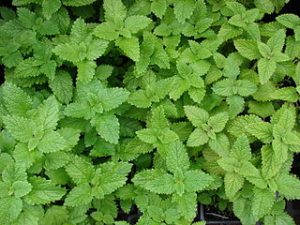
Lemon balm looks a lot like mint. It’s a close cousin, that’s why.
After flowering, growth can get leggy and the heat can cause the leaves to look splotchy and brown. Just prune it to the ground and you’ll have lush, new growth in a few weeks. By Fall, your plant will be its old self again, ready for harvesting more of those lemony, soothing leaves for tea, cakes and more.
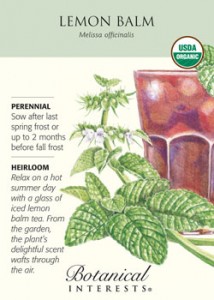
You can find seed for all your herb needs here at The Herb Cottage.
In many places in the country people look forward to summer to be outdoors tending their gardens, pruning, harvesting and keeping everything looking great. Here in Texas, by this time of year, much of our vegetable garden is finished- except for okra, eggplant, field peas (black eyes, crowder, lady creams, etc.) and hot peppers. Our herbs need pruning and most of the ornamental flowers we enjoyed in Spring are faded or gone.
It’s a time for the gardener to sneak out in the early morning and evenings to do a few things, then get in some shade with a cold drink and a good book, or back into the house where the AC is.
Taking some time now to prune and rejuvenate your herbs will give you a healthier and more productive plant in the fall as the days shorten and cool down. Don’t stress yourself in the heat. Take breaks to enjoy your herbal teas in the shade when you are outdoors. Remember… even in Texas… summer doesn’t last forever!
QUOTE FOR THE MONTH
If ever the time should come, when vain and aspiring men shall possess the highest seats in government, our country will stand in need of its experienced patriots to prevent its ruin.
-Samuel Adams, revolutionary (1722-1803)
